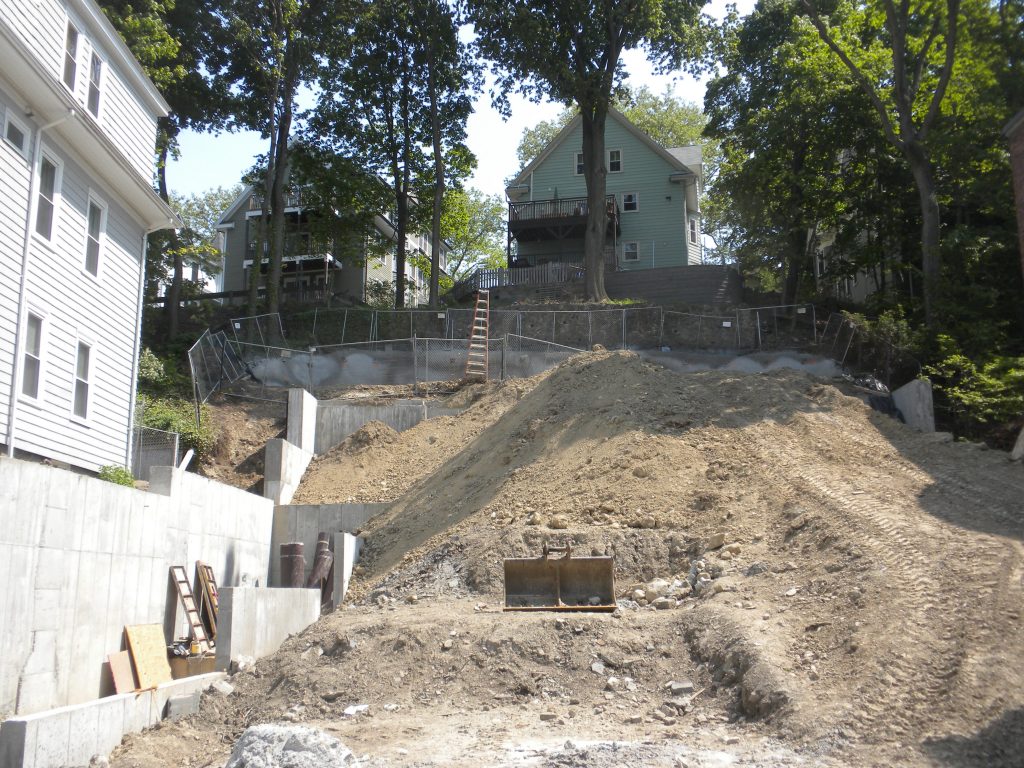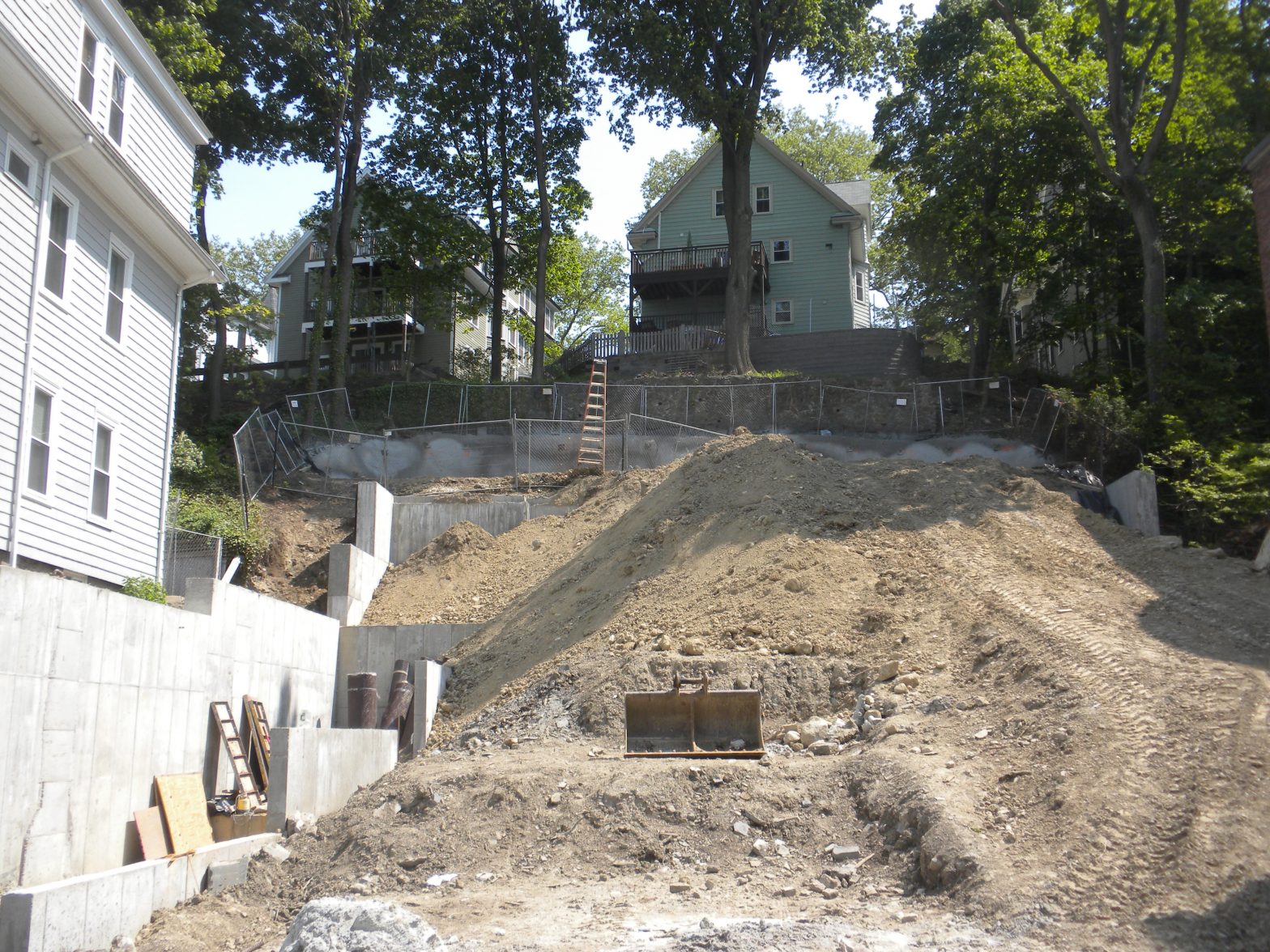 With high property values and space at a premium, construction in cities and urban suburbs usually involves redeveloping or expanding the built-up area of a previously occupied lot or collection of lots in an established neighborhood. To maximize the utilization of land, projects are often designed such that the built-up area, including buildings, accessory structures, parking and landscaping are built-up to the property line.
With high property values and space at a premium, construction in cities and urban suburbs usually involves redeveloping or expanding the built-up area of a previously occupied lot or collection of lots in an established neighborhood. To maximize the utilization of land, projects are often designed such that the built-up area, including buildings, accessory structures, parking and landscaping are built-up to the property line.
In some circumstances, the owner of a project or their contractor may request that access to perform work on abutting properties so that the project can make the greatest use possible of the buildable area on the site. This frequently occurs in major cities where buildings extend to the boundaries of the lots on which they are built. When a new building is constructed along a lot line shared with another building, it is often necessary for the constructor to perform work on the adjacent structure to temporarily or permanently protect it from damage. Underpinning of foundations, roof protection, weatherproofing and stabilization of former party walls, removal of encroachments, and installation of flashing between buildings are common examples.
For other projects, fully utilizing the site might require the construction of retaining structures along property lines. Retaining structures might be necessary to support the excavation of the new building’s basement. Alternatively, grading the site to maximize buildable area might require retaining ground on abutting properties or raising grade above adjacent properties. To some extent or another, it may be necessary or at least convenient to construct these retaining structures from or on the adjacent properties. At the end of the project, elements of the retaining structure may remain on the adjacent property, either in service or abandoned in place, typically below ground.
Access Agreements
Before work on a project can extend beyond the property lines of the site, the project owner or contractor must receive permission to enter abutting properties and may have to secure temporary or permanent easements for temporary or permanent work on the abutting property. However, if an abutter’s failure to cooperate would unreasonably prevent the project from proceeding, the project owner can sometimes seek the intervention of a court to compel cooperation.
An abutter property owner receiving a request for an access agreement in connection with adjacent construction will typically need professional assistance. First, they will need an attorney familiar with the construction process to ensure that the abutter’s rights are protected and that the access agreement is fair and contractually insulates the abutter from risk. For example, the abutter should be shielded from liability for personal injury and property damage caused by the project constructor while working on their property. Second, the abutter may need the assistance of a consulting engineer to review the work to be performed on the property or potentially impacting the property.
Underpinning
The underpinning of a lot line building is a typical example of work on adjacent property that should be professionally reviewed for the abutting property owner. Underpinning is a type of specialty construction that can be hazardous if not properly designed and constructed. Most projects delegate the design of underpinning and other protective works to the constructor who is incentivized to choose the most efficient and cost-effective means and methods to complete their work.
While competent contractors understand that unsafe work is bad for business, contractors must be somewhat risk-tolerant to be profitable. Instead of prevention, compensation after the fact through insurance might be the most cost-effective approach for a contractor to manage risks to third-party properties. Therefore, a contractor’s underpinning design might be optimized for cost and schedule and may subject an abutter to elevated risks that their building may be damaged, may be unavailable for use, may require increased maintenance and may be diminished in value.
An abutter’s risk profile is different from the contractor’s; prevention will almost always be preferable to compensation. The review of underpinning plans by a qualified consulting engineer provides an opportunity to identify unacceptable risks and even resolve faulty design assumptions. Better aligning the underpinning design with the abutter’s risk tolerance can be a condition of the access agreement.
Lot Line Retaining Structures
When lot line retaining structures are used to lower ground or excavate a project site, part of, if not the entire structure is usually on the abutting property. Gravity retaining walls and mechanically reinforced earth walls, require substantial excavation, which would encroach on the abutting property, even if the structure remains on the project site. For soil nail walls and tied-back temporary or permanent excavation support, tension elements are drilled into the ground below the abutting property.
These retaining structures can impact future use of the abutting property. The presence of retaining structure elements, even if decommissioned after completion of the project, will present obstructions to construction on the abutting property. In addition, the retaining structures are designed to support a particular occupancy load applied to the ground retained, which limits how the abutting property within the zone of influence of the retaining structure can be used. And since failure of the structure would compromise the abutting property, the abutter has an interest in its design, construction and maintenance. The abutter’s various interests and risks can be managed if the access agreement is contingent on the abutter’s engineer reviewing the design and construction of the retaining structure.
Monitoring
Risks associated with lot line underpinning, excavation support and other retaining structures cannot be completely eliminated even when reviewed by the abutter’s engineer. These types of work, like pile driving and other construction activities potentially impacting adjacent properties, require monitoring. Construction monitoring is a means of controlling risk by regularly measuring phenomena of interest and identifying deviations from expectations. The monitoring techniques used will depend on the project, but will typically include visual observations and displacement measurements of potentially impacted structures. Vibrations from construction activities and changes in groundwater levels may be of interest as well.
Monitoring should be addressed by access agreements. Generally, the abutter should be provided with all monitoring data relevant to their property and especially data from monitoring points on the property for review by their engineer. An access agreement might be need to cover the placement and reading of monitoring points on the property.
In densely developed areas, abutting properties are often exposed to risk or otherwise affected by construction. That makes the abutting property owners stakeholders in the performance of the project, even if they are not beneficiaries of it. Communication and cooperation between the project team and the abutting property owners is the best approach for reducing risk for all involved.
The process of negotiating an access agreement for work connected to an adjacent construction project presents the abutter with an opportunity to be informed about the proposed work, identify risks and mitigate those risks through conditions to the access agreement. Design changes, sharing of monitoring data and observation of work by the abutter’s engineer can be stipulated by the access agreement. Abutters should look beyond compensation when negotiating access agreements and ensure that the agreement provides the means to manage their risk exposure, including an independent professional review of potential impacts and stipulations for risk mitigation and control measures.
The information and statements in this document are for information purposes only and do not comprise the professional advice of the author or create a professional relationship between reader and author.
